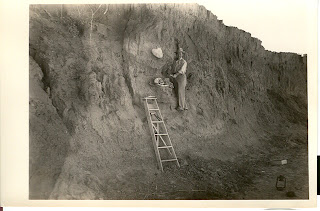 the archaeologist
the archaeologistThe last buffalo killed in Jack County was a tame buffalo of Dr. Cornelius, killed in 1875 by Alf and Mary Casey through mistake, out hunting in the Lost Valley. Of course they very much regretted the killing. (Ninety-four Years in Jack County)
Humans have resided in the canyon for approximately 12,000 years. Early settlers were nomadic tribes that hunted mammoth, giant bison, and other large game animals. Later, Apache Indians lived in the canyon, but were soon replaced by Comanche and Kiowa tribes who resided in the area until 1874. At that time, Col. Ranald Mackenzie was sent into the area to transport the Native Americans to Oklahoma. Col. Mackenzie and the 4th Cavalry were able to capture over 1,400 horses belonging to the tribe. After keeping some of the best horses for themselves, the remainder were taken to nearby Tule Canyon and destroyed. Cut off from their only means of transportation, the Native Americans soon surrendered.
One of the odd cominglings of blood and geography in my family--the paths we etch into the landscape with our desires, the trails of tears. I spent many childhood summers in the canyon, and its cool recesses lurk wolf-like along the perimeter of my imagination on hot summer nights. Before the roads were paved and the state park mitigated the wildness to the greatest extent to promote tourism, we wound down hairpin turns over seasonal creeks that had washed many away to their deaths during flash floods. We passed nights in an old German stone house, solid in the core, with a large hearth, louvered windows and French doors that opened onto a screened porch that completely enclosed the stone core, as wide, or wider, on each side than the diameter of the interior. This is where we slept, or tried to sleep, through the sweltering nights amid the deafening drone of crickets and the haunting whistle of trains and the mournful calls of owls. Perspiration gathered on our necks and behind our knees, and we dreamed fitful dreams of water snakes and wild indians.
My great grandfather, as amateur archaeologist, had haunted this landscape long before this, knapping flint and excavating artifacts for the Museum. But long before even that, the Kiowa and Comanche had roamed the fertile riparian paths. Satanta was among them, a great warrior for whom my grandmother's paternal great-grandparents had delivered his infant son at their mercantile outside Fredricksburgh. Later this child would mature into a young man, and her maternal great-grandfather in Jack County would sentence him to be hanged.
Theodore Specht, Fredericksburg pioneer, was born in the province of Braunschweig, Germany, on April 17, 1810. He became captain of a sailing ship in Germany, and on his last voyage his ship was destroyed and he was believed drowned. Although Specht was eventually rescued, the accident cost him his hearing and his fiancée, who, believing he was dead, married another man. Specht eventually married Maria Berger in Germany and immigrated with her to Fredericksburg, Texas, in 1846. Their first child, Christine, was born on March 14, 1846, but died of exposure in a spring storm when she was only a few days old despite being held by her mother in a feather bed. Specht and his wife had seven other children who lived to adulthood. In his home Specht opened a store that became popular with the local Indians, who traded honey, bear fat, and meat with the colonists. The Comanche chief Santa Anna* was a friend of Specht's; one winter night he rode up with one of his wives and asked for a room with a fireplace for her. She bore him a son that night, and when he returned the next morning he asked Mrs. Specht to follow him to the creek, where he broke the ice and dipped the baby in the water. He then patted a handful of water on Maria's breast, proclaimed her the mother-in-God of his son, and gave her an engraved silver disk in payment for the lodgings. Specht became the first postmaster of Fredericksburg on December 7, 1848; he operated the post office in his store and was the local agent for the Neu Braunfelser Zeitung beginning in 1852. Through the Department of Agriculture he brought into Gillespie County a variety of wheat and rye that benefited local farmers. He also collected local insects, lizards, and snakes, preserved them in alcohol and shipped them to naturalists in New York; he sent the money he received from them to his mother in Germany. Specht died on June 4, 1862, and was buried in Fredericksburg.
*This is excerpted from the Handbook of Texas online. Later research would show that this story is only partially true. The Indian chief was the Kiowa "Satanta," not Santa Anna, and Theodor Zeisig Specht entered the port at Galveston on the ship, The Louise, with eight children, the youngest being two at the time. Maria Bergert was a Catholic from Braunschweig, as verified through the meticulous German Catholic christening records. Theodor was actually from Poland, and very probably Jewish (as evidenced from various phrases and cultural habits my grandmother recalls)--he was not present at any of the christening ceremonies of his children. The shipwreck is completely unverifiable.
The record of the Texas penitentiary in regard to these two distinguished prisoners is as follows:
Name—Satanta, Kiowa Chief, Registered No. 2107, Age unknown.
Nativity—Indian Country. Time Convicted—July term, 1871.
Offense—Murder. Occupation—None. Term of Sentence—Life.
Education—None. Use tobacco—Yes. Height—Five feet nine and one half inches. Complexion—Copper. Color Eyes—Black. Color of Hair—Black. Married—Yes. Residence—Indian territory. Money—None. Received—Novembe 2, 1871. Expiration—Life.
(from Ida Lasiter Huckaby, Ninety-four Years in Jack County)



